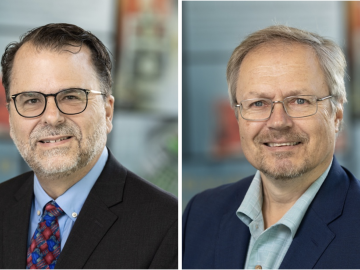
Filter News
Area of Research
- Biology and Environment (6)
- Clean Energy (23)
- Computer Science (3)
- Electricity and Smart Grid (1)
- Functional Materials for Energy (1)
- Fusion and Fission (4)
- Isotope Development and Production (1)
- Isotopes (1)
- Materials (42)
- Materials Characterization (1)
- Materials for Computing (5)
- Materials Under Extremes (1)
- National Security (1)
- Neutron Science (16)
- Nuclear Science and Technology (1)
- Quantum information Science (2)
- Supercomputing (17)
News Type
News Topics
- (-) Buildings (21)
- (-) Materials Science (57)
- (-) Quantum Science (29)
- 3-D Printing/Advanced Manufacturing (52)
- Advanced Reactors (13)
- Artificial Intelligence (37)
- Big Data (12)
- Bioenergy (24)
- Biology (23)
- Biomedical (18)
- Biotechnology (8)
- Chemical Sciences (38)
- Clean Water (2)
- Climate Change (26)
- Composites (12)
- Computer Science (66)
- Coronavirus (17)
- Critical Materials (11)
- Cybersecurity (18)
- Decarbonization (24)
- Education (3)
- Element Discovery (1)
- Energy Storage (47)
- Environment (45)
- Exascale Computing (13)
- Fossil Energy (1)
- Frontier (17)
- Fusion (18)
- Grid (19)
- High-Performance Computing (35)
- Irradiation (1)
- Isotopes (22)
- ITER (2)
- Machine Learning (14)
- Materials (69)
- Mercury (2)
- Microelectronics (1)
- Microscopy (18)
- Molten Salt (3)
- Nanotechnology (28)
- National Security (22)
- Net Zero (4)
- Neutron Science (58)
- Nuclear Energy (35)
- Partnerships (30)
- Physics (24)
- Polymers (13)
- Quantum Computing (11)
- Renewable Energy (1)
- Security (12)
- Simulation (12)
- Software (1)
- Space Exploration (3)
- Statistics (1)
- Summit (22)
- Sustainable Energy (37)
- Transformational Challenge Reactor (4)
- Transportation (33)
Media Contacts

A study led by the Department of Energy’s Oak Ridge National Laboratory details how artificial intelligence researchers created an AI model to help identify new alloys used as shielding for housing fusion applications components in a nuclear reactor. The findings mark a major step towards improving nuclear fusion facilities.

Stephen Kowalski and Mikael Salonvaara received the Distinguished Service Award, which salutes members who have served the society with distinction in chapter, regional and society activities.

Kashif Nawaz, distinguished researcher and section head for Building Technologies Research at the Department of Energy’s Oak Ridge National Laboratory, has been named a Fellow of the American Society of Mechanical Engineers, or ASME.

A team led by scientists at ORNL identified and demonstrated a method to process a plant-based material called nanocellulose that reduced energy needs by a whopping 21%, using simulations on the lab’s supercomputers and follow-on analysis.

Flexcon Global has exclusively licensed two patented inventions to manufacture a self-healing barrier film from ORNL for research and development purposes. The film can be incorporated into vacuum insulation panels to increase the efficiency of buildings during retrofits. Under a cooperative research and development agreement that began in 2021, Flexcon and ORNL have been exploring the capabilities of the technology and fine-tuning its properties.

ORNL’s Joshua New was named the 2024 Researcher of the Year by R&D World magazine as part of its R&D 100 Professional Award winners.

DOE commissioned a neutron imaging instrument, VENUS, at the Spallation Neutron Source in July. VENUS instrument scientists will use AI to deliver 3D models to researchers in half the time it typically takes.

A study by more than a dozen scientists at the Department of Energy’s Oak Ridge National Laboratory examines potential strategies to integrate quantum computing with the world’s most powerful supercomputing systems in the pursuit of science.

Seven entrepreneurs comprise the next cohort of Innovation Crossroads, a DOE Lab-Embedded Entrepreneurship Program node based at ORNL. The program provides energy-related startup founders from across the nation with access to ORNL’s unique scientific resources and capabilities, as well as connect them with experts, mentors and networks to accelerate their efforts to take their world-changing ideas to the marketplace.

The American Society of Heating, Refrigeration and Air-Conditioning Engineers, or ASHRAE, selected Jason DeGraw, a researcher with ORNL, as one of 23 members elevated to Fellow during its 2024 winter conference.


